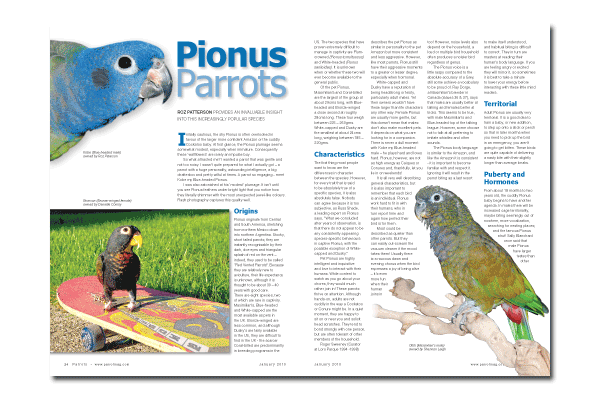Pionus Parrots
Roz Patterson provides an invaluable insight into this increasingly popular species.
Initially cautious, the shy Pionus is often overlooked in favour of the larger more confident Amazon or the cuddly Cockatoo baby. At first glance, the Pionus plumage seems somewhat modest, especially when immature. Consequently these ‘wallflowers’ are rarely an impulse buy.
So what attracted me? I wanted a parrot that was gentle and not too noisy. I wasn’t quite prepared for what I actually got – a parrot with a huge personality, astounding intelligence, a big chatterbox and pretty wilful at times. A parrot so engaging - meet Kobe my Blue-headed Pionus.
I was also astonished at his ‘modest’ plumage. It isn’t until you see Pionus feathers under bright light that you notice how they literally shimmer with the most unexpected jewel-like colours. Flash photography captures this quality well.
Origins
Pionus originate from Central and South America, stretching from northern Mexico down into northern Argentina. Stocky, short tailed parrots, they are instantly recognisable by their dark, doe eyes and triangular splash of red on the vent – indeed, they used to be called “Red Vented Parrots”. Because they are relatively new to aviculture, their life expectancy is unknown, although it is thought to be about 30 – 40 years with good care. There are eight species, two of which are rare in captivity. Maximilian’s, Blue-headed and White-capped are the most available as pets in the UK. Bronze-winged are less common, and although Dusky’s are fairly available in the US, they are difficult to find in the UK - the scarcer Coral-billed are predominantly in breeding programs in the US. The two species that have proven extremely difficult to manage in captivity are Plum-crowned (Pionus tumultuosus) and White-headed (Pionus seniloides). It is unknown when or whether these two will ever become available to the general public.
Of the pet Pionus, Maximilian’s and Coral-billed are the largest of the group at about 29cms long, with Blue-headed and Bronze-winged a close second at roughly 28cms long. These four weigh between 225 – 260gms. White-capped and Dusky are the smallest at about 24cms long, weighing between 185 – 220gms.
Read more in the magazine…

